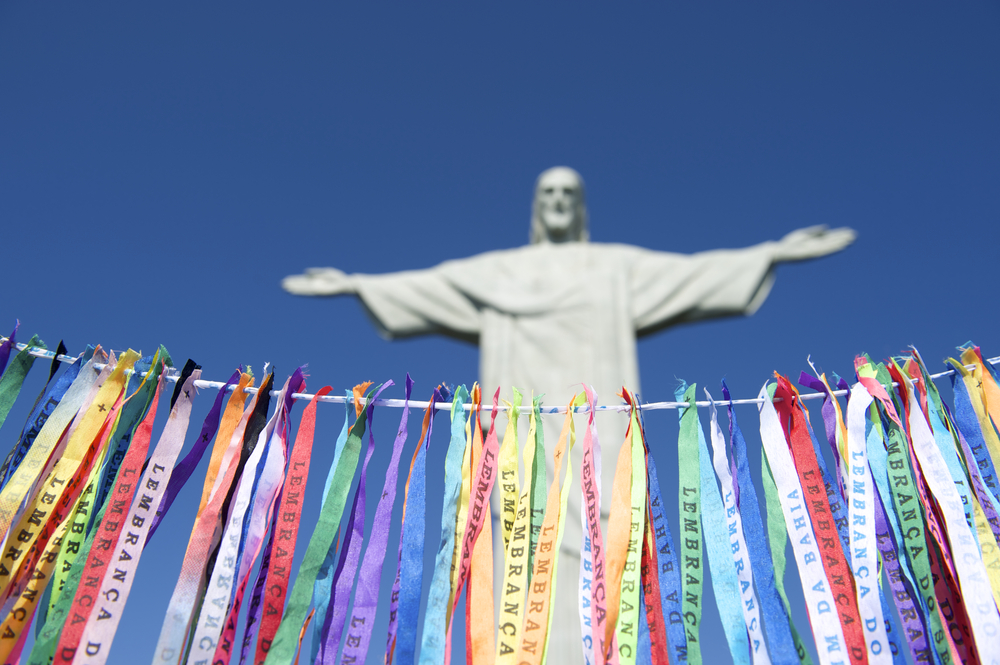Maybe you’re not that religious. Or you’re not completely sure what the deal is with Lent, the Christian observance that runs the six weeks from Ash Wednesday to Easter Sunday. But that’s okay. Because even if you aren’t exactly faithful or fully in the know on the ins and outs of religious traditions and holidays, you can still get in on all the partying that goes down because of it! And trust us, there’s a lot of partying.
In fact, the two biggest and best parties in the world happen every year because of Lent: Mardi Gras in New Orleans and Carnival in Rio de Janeiro. The story goes that early Christians wanted to celebrate and have a good time before the somberness and major abstaining of Lent. The tradition spread, morphed, and has continued on in many Christian-celebrating cultures.
So gas up the car and/or get out the passport, it’s time to P-A-R-T-Y.
How to Get Down at Mardi Gras in New Orleans

“Kosmic Frenchmen Purple Face” by Infrogmation of New Orleans is licensed under CC 2.0.
There are stories of Mardi Gras Mardi Gras celebrations in New Orleans as far back as the 1700s, but there wasn’t an official organized Mardi Gras effort in the city until the 1830s. Today, the day whose name is French for “Fat Tuesday” (the day before Ash Wednesday) is a recognized city holiday.
New Orleans’ Mardi Gras season begins in January, on “Epiphany,” which is exactly 12 days after Christmas. Starting then, groups known as “krewes” organize parades, masquerade balls, and parties with increasing frequency until the big day, which explodes with parties, balls, and parades. Parades are pretty much THE big thing during Mardi Gras season with several different ones happening each day, each sponsored and run by its own krewe. From the parade floats, krewe members toss out “throws” to spectators and are usually the infamous beads (you know what we’re talking about about) and doubloons (souvenir coins with the krewe’s symbol).
The big thing to remember in celebrating New Orlean’s Mardi Gras is that you should get there a few days early (the city reportedly doubles its population in the five days before Mardi Gras) to get in on the fun. You should also do your research on the different krewes and see which ones’ parades you want to check out. You may be tempted to dress up in some Mardi Gras costumes, but it’s generally considered poor taste to do it as non-krewe member on any day OTHER than Mardi Gras itself. Oh, and make sure to bring a plastic cup, since open containers are legal in New Orleans as long as it’s not glass!
How to Party Hard at Carnival in Rio de Janeiro

“E70A3113.jpg” by nateClicks is licensed under CC 2.0.
Carnival in Rio is a lot like Mardi Gras in New Orleans, but a bit more intense. It’s rooted in the same Christian cultural traditions of partying before Lent. And like Mardi Gras, there are plenty of parades, elaborate costumes, and balls—but Rio’s Carnival features WAY more dancing. Similar festivals are abundant in South America, but Rio’s is the largest in the world with an estimated two million people celebrating each day.
Carnival celebrations in Rio de Janerio reportedly go back to the 1700s. The festival takes over the city from the Friday before all the way to Ash Wednesday with different events and celebrations each day. Unlike resident of New Orleans, the people of Rio don’t build to a certain day—they just party hard for 5 days straight. Like with the krewes in New Orleans, Rio’s Carnival features several different groups and organizations doing their own thing.
There are the samba schools, who create unique dance shows that sometimes tell a story and feature performers on and around parade floats (a typical parade will features floats from different samba schools). There are also various masquerade balls and high end parties throughout the festival.
But the big part of Carnival in Rio is the street celebrations, organized by blocos and bandas (city blocks and sections). They can be more casual affairs featuring parades, music, dancing, and partying on the street and are open to anyone and everyone.
The big parade during Rio’s Carnival goes down at the Sambadrome, a spectator seated parade ground where you can watch samba schools compete, but you’ll need to buy a ticket to get a seat. You can also get tickets to attend a ball, if you’re feeling fancy. But if you really want to party with the locals of Rio, you should check out the street festivals. There are guides to the different blocos and bandas that describe what each one usually does each year, so you can find the right one for you.
Are you ready to celebrate Mardi Gras or Carnival? Have a secret or tip for anyone heading to New Orleans or Rio? Leave it in the comment section below!



